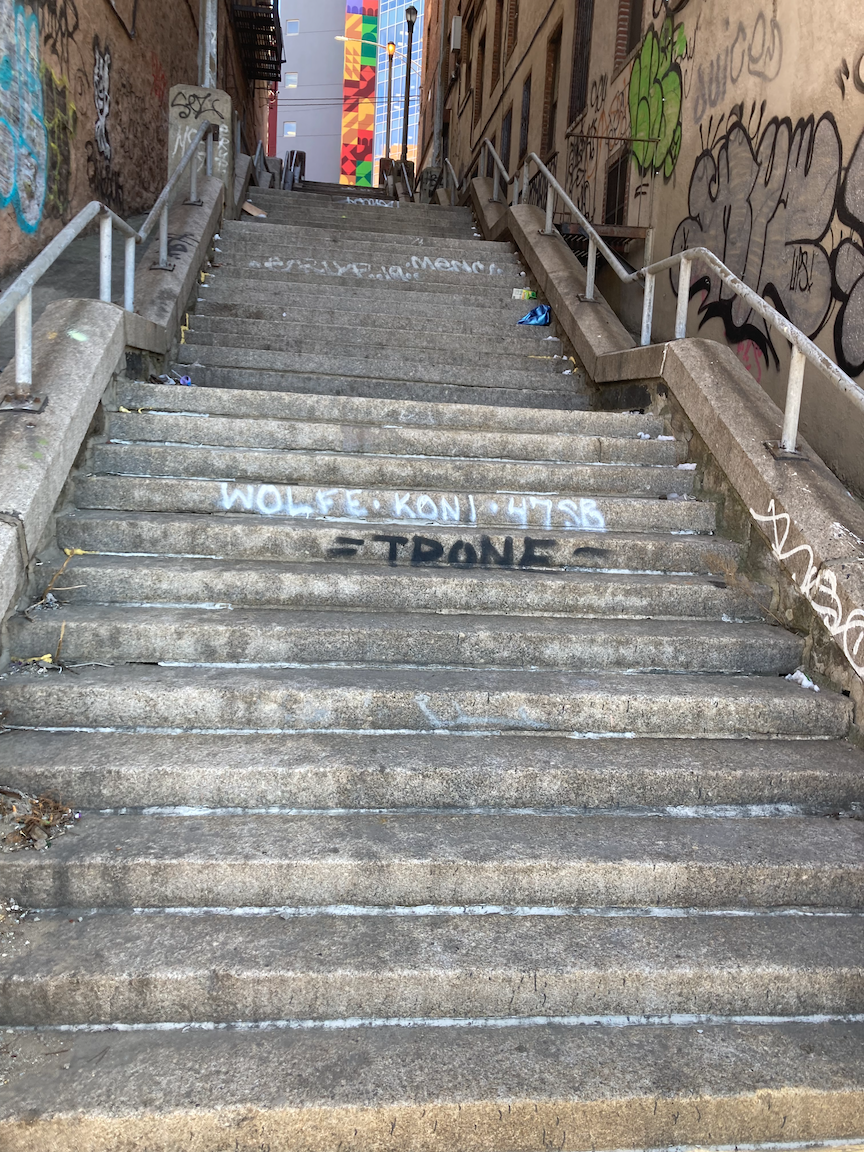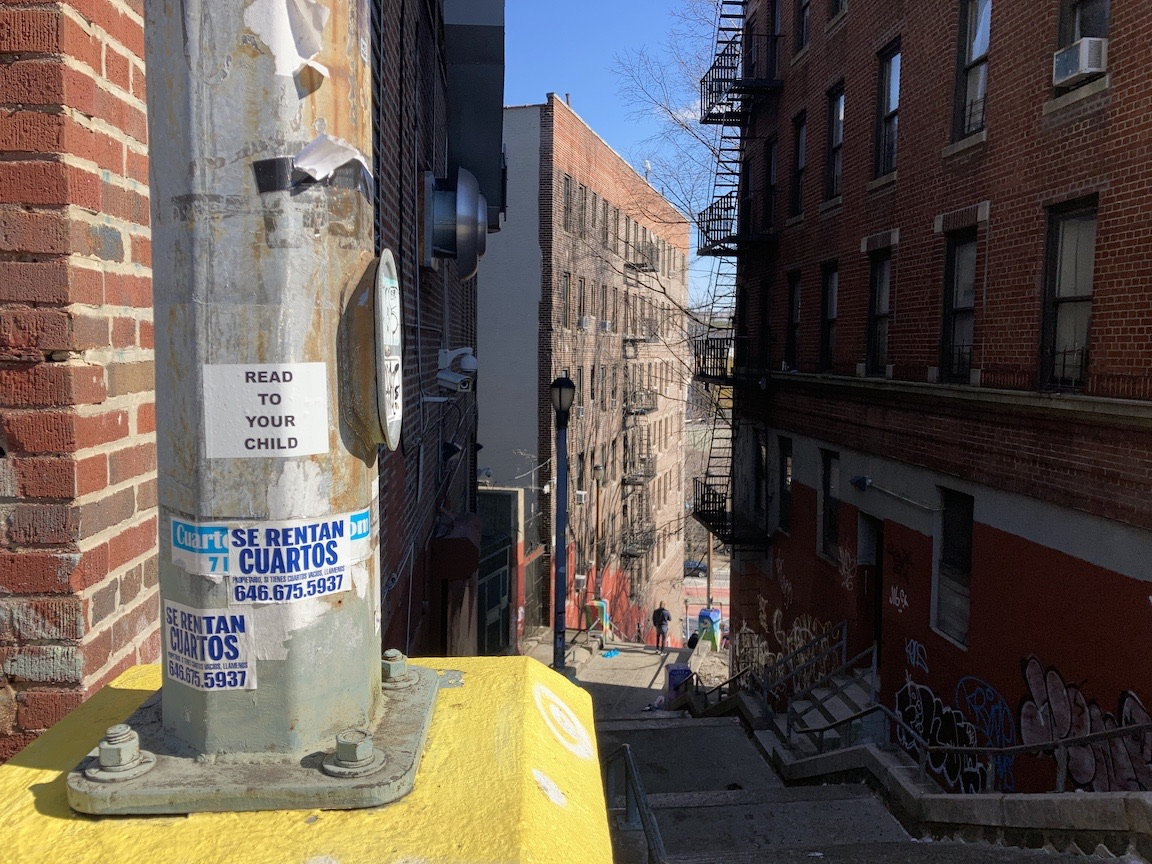Urban Mountaineering in the Bronx
East 165 Street (Jerome Slope) stairs.
Route of this walk, reading from bottom to top.
WHERE: Stair streets at East 165 Street (Jerome Slope), West 161 Street, two between Sedgwick and University Avenues, West 165 Street, and West 168 Street (Shakespeare Steps)
START: 161 Street - Yankee Stadium subway station (4 and D trains, fully accessible)
FINISH: University Avenue north of the Washington Bridge, then Bx3 bus
DISTANCE: 2.7 miles (3.9 kilometers)
Photographs by Michael Cairl except as noted. Maps by Google Maps.
Profile of this walk, reading from left to right.
On this cold, clear day it was to tackle the stair streets in the High Bridge section of the Bronx that I hadn’t yet attempted that I made this trip, and these provided a good workout. But this very hilly part of the Bronx gave me a lot of good hill climbing away from the stair streets.
I started at Yankee Stadium, deserted except for a mobile COVID-19 vaccination site. En route to the first of today’s stair streets, at East 165 Street and Jerome Avenue, I passed part of the remains of a long-gone station of the Ninth Avenue Elevated. Just prior to World War I, the Second, Third, and Ninth Avenue elevated train lines in Manhattan were expanded to allow peak-direction express service and were connected to the Interborough Rapid Transit (IRT) subway in the Bronx. The Ninth Avenue line was extended from its previous terminus at West 155 Street and 8 Avenue, at the Polo Grounds stadium, across a bridge formerly used by the Putnam Division of the New York Central, through a new tunnel bored beneath West 162 Street, and onto an elevated structure from Jerome Avenue to connect with the IRT’s new elevated Woodlawn line at River Avenue. Service on the line south of 155 Street was discontinued in 1940, and the remnant operated as the Polo Grounds Shuttle until 1958. It was discontinued when the already low ridership dwindled to almost nothing after the Giants baseball team left New York and their home stadium, the Polo Grounds, after the 1957 season. (For more about the Polo Grounds see my post “Hamilton Heights, Sugar Hill, Polo Grounds” on this page.) What I saw from Jerome Avenue was the retaining wall and a fenced-off area where part of the Jerome-Anderson Avenues station was.
Jerome-Anderson Avenues station in its final years. The buses are parked on East 162 Street, since demapped. The viaduct crossing Jerome Avenue is gone. Photo courtesy of nycsubway.org, Joe Testagrose collection.
Left: Inside the fenced area atop the retaining wall were the two tracks and platform of the Jerome-Anderson station. Right: snazzy Art Deco apartment building at 1001 Jerome Avenue.
The Jerome Slope (East 165 Street) stairs are the most southerly of a group of four that includes the Joker Stairs. At 142 steps this is the longest of the four. These zigzag up to a playground on Anderson Avenue. The stairs themselves are in decent condition but there are two sections without a handrail on the right side going up, but I was able to climb slowly and with my cane. Parks Department: these are your stairs, this would be an inexpensive fix, please do it!
Views of and from the Jerome Slope stairs. The last two images show the sections needing a handrail, the first being at the bottom, the second about halfway up.
From the top of the stairs I walked downhill on steep Anderson Avenue, uphill on West 162 Street, downhill on Ogden Avenue, and uphill on West 161 Street to the next stairs, 53 steps down from Summit Avenue to Sedgwick Avenue. From this point to the High Bridge, Sedgwick Avenue is little more than a service (frontage) road for the Major Deegan Expressway (Interstate 87). On my way to the West 165 Street stairs I encountered two small stair streets between Sedgwick Avenue and University Avenue that were not on the map, so I walked down the first set (8 steps) and up the second (29 steps). The second set of stairs has no handrails at all but has brackets that once supported them. This stairway might not get much use but installing handrails would not be expensive. Department of Transportation, this one’s on you. The next stair street, West 165 Street, is 73 steps down from University Avenue to Sedgwick Avenue. The stairs are in fair condition but would benefit from new handrails and picking up a lot of trash.
Stairs at the junction of Sedgwick and University Avenues, stairs between the same two streets (no handrails) a bit farther north, viewed from bottom and top.
West 165 Street stairs, looking down and looking up.
From the bottom of West 165 Street I walked north on desolate Sedgwick Avenue to West 167 Street, mostly uphill to the last stair street of the day, at West 168 Street. These are also known as the Shakespeare Steps as they run from Shakespeare Avenue at the top to Edward L Grant Highway at the bottom, 124 steps.
From the bottom of the West 168 Street stairs I had a steady uphill, a good workout, to the end point of this walk, on University Avenue just north of where it crosses the Cross Bronx Expressway (Interstate 95), which was congested as usual.
The stair streets I visited on this trip are not in top condition and the best overall are at West 168 Street. I would like to see all of them rebuilt but making sure all of them have continuous handrails on both sides isn’t much to ask. This was good exercise in a part of town I’ve had the pleasure of visiting several times now. I’ll surely visit these stairs again.
Stair recap: East 165 Street (Jerome Slope) - 142 steps up, West 161 Street - 53 steps down, University Avenue to Sedgwick Avenue - 8 steps down, Sedgwick Avenue to University Avenue - 29 steps up, West 165 Street - 73 steps down, West 168 Street (Shakespeare Steps) - 124 steps down, total 429 steps.
SO … Who was Major Deegan, namesake of the Major Deegan Expressway? William Francis Deegan (1882-1932) was an architect, organizer of the American Legion, major in the Army Corps of Engineers, Democratic political leader in New York City, and president of the Bronx Chamber of Commerce.
AND … Who was Edward L. Grant, memorialized by the wide street called Edward L. Grant Highway? Eddie Grant (1883-1918) was a Major League Baseball player who retired in 1915. When the United States entered World War I in 1917 Grant enlisted in the Army and was killed in combat in the Meuse-Argonne offensive in October 1918.


















